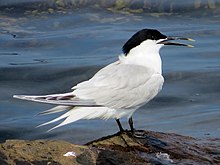|
Sandwich tern
The Sandwich tern (Thalasseus sandvicensis)[2] is a tern in the family Laridae. It is very closely related to the lesser crested tern (T. bengalensis), Chinese crested tern (T. bernsteini), Cabot's tern (T. acuflavidus), and elegant tern (T. elegans) and has been known to interbreed with both elegant and lesser crested. It breeds in the Palearctic from Europe to the Caspian Sea and winters in South Africa, India, and Sri Lanka. The Sandwich tern is a medium-large tern with grey upperparts, white underparts, a yellow-tipped black bill, and a shaggy black crest which becomes less extensive in winter with a white crown. Young birds bear grey and brown scalloped plumage on their backs and wings. It is a vocal bird. It nests in a ground scrape and lays one to three eggs. Like all Thalasseus terns, the Sandwich tern feeds by plunge diving for fish, usually in marine environments, and the offering of fish by the male to the female is part of the courtship display. TaxonomyThe terns are small to medium-sized seabirds, gull-like in appearance, but usually with a more delicate, lighter build and shorter, weaker legs. They have long, pointed wings, which gives them a fast buoyant flight, and often a deeply forked tail. Most species are grey above and white below, and have a black cap which is reduced or flecked with white in the winter.[3] The Sandwich tern was originally described by ornithologist John Latham in 1787 as Sterna sandvicensis, but was moved to its current genus Thalasseus (Boie, 1822) following mitochondrial DNA studies which confirmed that the three types of head pattern (white crown, black cap, and black cap with a white blaze on the forehead) found among the terns corresponded to distinct clades.[2] The current genus name is derived from Greek Thalassa, "sea", and sandvicensis, which, like the English name, refers to Sandwich, Kent, Latham's type locality.[4] This bird has no subspecies. Two former subspecies are now treated as a separate species, Cabot's tern (T. acuflavidus); this breeds on the Atlantic coasts of North America, northern and eastern South America, and has wandered to Western Europe. Description This is a medium-large tern, 36–41 cm (14–16 in) long with an 95–105 cm (37–41 in) wingspan, which is unlikely to be confused within most of its range. The weight ranges from 200–300 g.[5] The Sandwich tern's thin, sharp bill is black with a yellow tip. Its short legs are black. Its upper wings are pale grey and its underparts white, and this tern looks very pale in flight, although the primary flight feathers darken during the summer.[6] In winter, the adult Sandwich tern's forehead becomes extensively white. Juvenile Sandwich terns have dark tips to their tails, an all-blackish bill (lacking the yellow tip, but sometimes yellowish at the base) and a scaly appearance on their back and wings, like juvenile roseate terns but with less black on the crown.[6] The lesser crested tern and elegant tern differ in having all-orange bills; lesser crested also differs in having a grey rump and marginally stouter bill, and elegant in having a slightly longer, more slender bill. The Chinese crested tern is more similar to the Sandwich tern, but has a reversal of the bill colour, yellow with a black tip; it does not overlap in range with the Sandwich tern so confusion is unlikely. Cabot's tern is the most similar, sharing the black bill with a yellow tip, but differs in the bill being obviously stouter, and also differs in moult timing, losing its black forehead earlier in the summer. Its juveniles also lack the scaly pattern of Sandwich tern, being a plainer grey (though this can be confused with first-winter plumage of Sandwich tern).[7] The Sandwich tern is a vocal bird; its call is a characteristic loud grating kear-ik or kerr ink.[6] BehaviourThis species breeds in very dense colonies on coasts and islands, and exceptionally inland on suitable large freshwater lakes close to the coast. It nests in a ground scrape and lays one to three eggs. Unlike some of the smaller white terns, it is not very aggressive toward potential predators, relying on the sheer density of the nests—often only 20–30 cm (7.9–11.8 in) apart and nesting close to other more aggressive species such as Arctic terns and black-headed gulls to avoid predation. Like all Thalasseus terns, the Sandwich tern feeds by plunge-diving for fish, almost invariably from the sea. It usually dives directly, and not from the "stepped-hover" favoured by Arctic terns. The offering of fish by the male to the female is part of the courtship display. StatusThe Sandwich tern has an extensive global range estimated at 100,000–1,000,000 km2 (39,000–386,000 sq mi). It has a population estimated at 460,000–500,000 individuals. Population trends have not been quantified, but the species is not believed to approach the thresholds for the population decline criterion of the IUCN Red List (i.e., declining more than 30% in ten years or three generations). For these reasons, the species is evaluated as least concern.[1] The Sandwich tern is among the taxa to which the Agreement on the Conservation of African-Eurasian Migratory Waterbirds (AEWA) applies.[8] Parties to the agreement are required to engage in a wide range of conservation actions, which are describes in a detailed action plan. This plan should address key issues such as species and habitat conservation, management of human activities, research, education, and implementation.[9] Their habit of breeding in very dense colonies made them highly vulnerable to the 2021–2023 highly pathogenic avian influenza (HPAI) outbreaks, with mass mortality in numerous colonies in northwerstern Europe in 2022.[10] Gallery
References
Further reading
External linksWikimedia Commons has media related to Thalasseus sandvicensis. Wikispecies has information related to Thalasseus sandvicensis.
|
||||||||||||||||||||||||||||||||||||||||











